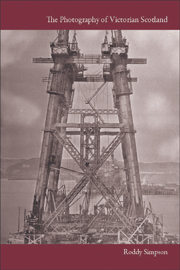Book contents
- Frontmatter
- Contents
- List of Figures
- Introduction
- 1 The Origins of Scottish Photography: Pioneering Activities in St Andrews and Edinburgh
- 2 David Octavius Hill and Robert Adamson: the ‘Partnership of Genius’ and the First Art Photography
- 3 Photography for the Few: The Activities of the Enthusiastic and Artistic Amateurs
- 4 Photography in Demand: The Work of the Increasing Number of Professional Photographers to Meet Public Demand
- 5 Scots Abroad: The Achievements of Scottish Photographers Around the World
- 6 Tourists and Travellers: Images of Scotland Produced for the Rapidly Growing Tourist Market and Photographs Taken by Visitors
- 7 Recording Social Conditions and Industrial Change: Photographs of what was Being Lost and what was Replacing it
- 8 Photography as Art: Looking at the Images and the Arguments
- 9 Populist Activity and Pictorialism: Popular Involvement with Cheap and Mass Produced Cameras and Photographers with Artistic Aspirations
- 10 Scotland's Enduring Photographic Legacy
- Bibliography
- Acknowledgements
- Index
9 - Populist Activity and Pictorialism: Popular Involvement with Cheap and Mass Produced Cameras and Photographers with Artistic Aspirations
Published online by Cambridge University Press: 05 August 2013
- Frontmatter
- Contents
- List of Figures
- Introduction
- 1 The Origins of Scottish Photography: Pioneering Activities in St Andrews and Edinburgh
- 2 David Octavius Hill and Robert Adamson: the ‘Partnership of Genius’ and the First Art Photography
- 3 Photography for the Few: The Activities of the Enthusiastic and Artistic Amateurs
- 4 Photography in Demand: The Work of the Increasing Number of Professional Photographers to Meet Public Demand
- 5 Scots Abroad: The Achievements of Scottish Photographers Around the World
- 6 Tourists and Travellers: Images of Scotland Produced for the Rapidly Growing Tourist Market and Photographs Taken by Visitors
- 7 Recording Social Conditions and Industrial Change: Photographs of what was Being Lost and what was Replacing it
- 8 Photography as Art: Looking at the Images and the Arguments
- 9 Populist Activity and Pictorialism: Popular Involvement with Cheap and Mass Produced Cameras and Photographers with Artistic Aspirations
- 10 Scotland's Enduring Photographic Legacy
- Bibliography
- Acknowledgements
- Index
Summary
There was a dramatic increase in popular participation in photography at the end of the nineteenth century because of technical improvements largely due to one man, George Eastman (1854-1932). It could be said that Eastman was the epitome of the American entrepreneur. By his mid-teens he was earning a living as a bank clerk but soon quit to set up the Eastman Dry Plate Company in Rochester, New York. He consistently made breakthroughs in technology and he was assisted in this by appointing the best people he could find. Eastman also introduced mass-production, but his greatest contribution to the popularisation of photography was a marketing idea. By offering a total package of camera, film and processing, Eastman eliminated at a stroke all the fuss and aggravation that had formerly been associated with photography. He also gave the world the name Kodak, a word he devised for the following reasons:
It was a purely arbitrary combination of letters, not derived in whole or part from any existing word, arrived at after a considerable search for a word that would answer all requirements for a trademark name. The principal of these were that it must be short; incapable of being mis-spelled so as to destroy its identity; must have a vigorous and distinctive personality; must meet the requirements of the various foreign trademark laws …
- Type
- Chapter
- Information
- The Photography of Victorian Scotland , pp. 175 - 185Publisher: Edinburgh University PressPrint publication year: 2012

